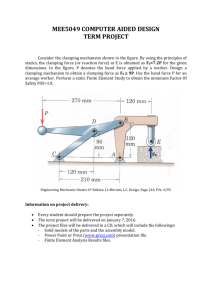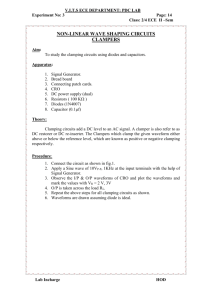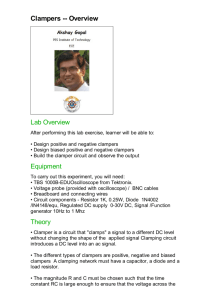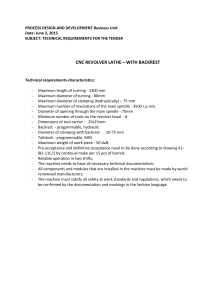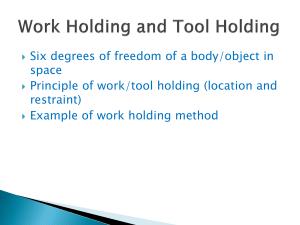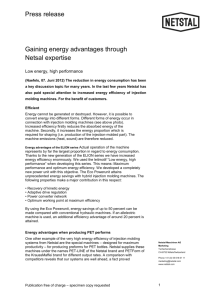work holding - macromachineinc
advertisement
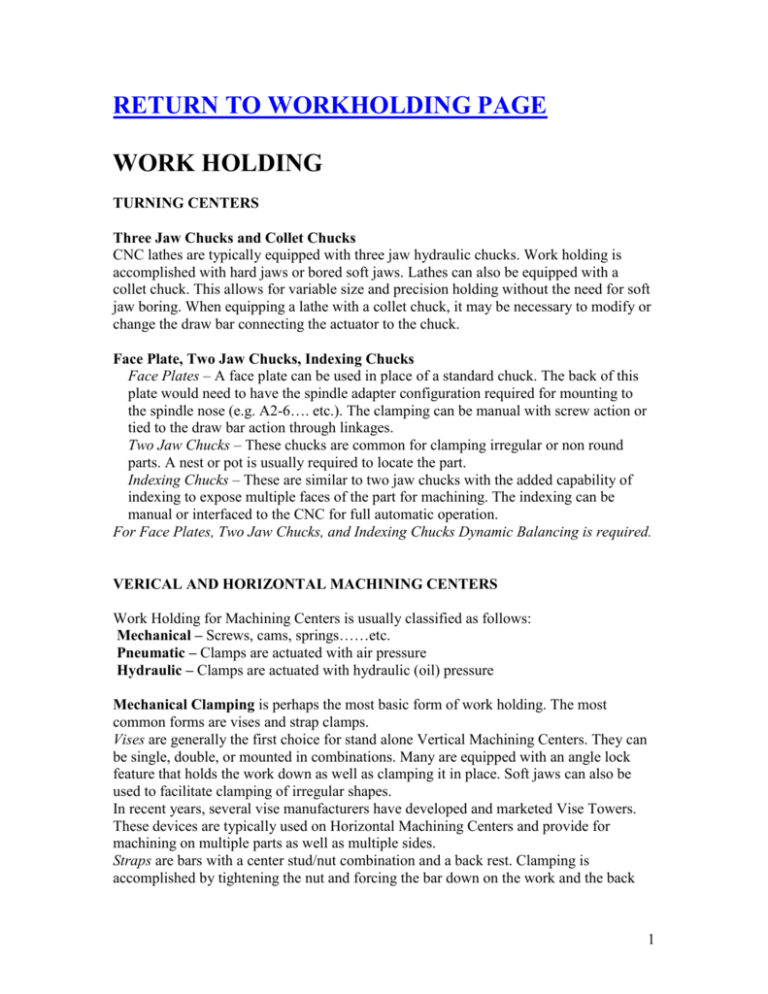
RETURN TO WORKHOLDING PAGE WORK HOLDING TURNING CENTERS Three Jaw Chucks and Collet Chucks CNC lathes are typically equipped with three jaw hydraulic chucks. Work holding is accomplished with hard jaws or bored soft jaws. Lathes can also be equipped with a collet chuck. This allows for variable size and precision holding without the need for soft jaw boring. When equipping a lathe with a collet chuck, it may be necessary to modify or change the draw bar connecting the actuator to the chuck. Face Plate, Two Jaw Chucks, Indexing Chucks Face Plates – A face plate can be used in place of a standard chuck. The back of this plate would need to have the spindle adapter configuration required for mounting to the spindle nose (e.g. A2-6…. etc.). The clamping can be manual with screw action or tied to the draw bar action through linkages. Two Jaw Chucks – These chucks are common for clamping irregular or non round parts. A nest or pot is usually required to locate the part. Indexing Chucks – These are similar to two jaw chucks with the added capability of indexing to expose multiple faces of the part for machining. The indexing can be manual or interfaced to the CNC for full automatic operation. For Face Plates, Two Jaw Chucks, and Indexing Chucks Dynamic Balancing is required. VERICAL AND HORIZONTAL MACHINING CENTERS Work Holding for Machining Centers is usually classified as follows: Mechanical – Screws, cams, springs……etc. Pneumatic – Clamps are actuated with air pressure Hydraulic – Clamps are actuated with hydraulic (oil) pressure Mechanical Clamping is perhaps the most basic form of work holding. The most common forms are vises and strap clamps. Vises are generally the first choice for stand alone Vertical Machining Centers. They can be single, double, or mounted in combinations. Many are equipped with an angle lock feature that holds the work down as well as clamping it in place. Soft jaws can also be used to facilitate clamping of irregular shapes. In recent years, several vise manufacturers have developed and marketed Vise Towers. These devices are typically used on Horizontal Machining Centers and provide for machining on multiple parts as well as multiple sides. Straps are bars with a center stud/nut combination and a back rest. Clamping is accomplished by tightening the nut and forcing the bar down on the work and the back 1 rest. Clamping force capabilities range from 500 lbs. for a ¼-20 stud to 5500 lbs. for a ¾10 stud (at 33% of stud yield). Of course, mechanical clamping can take many forms. Several adaptations of basic mechanical devices can provide for effective work holding. The main advantages to mechanical clamping are cost and versatility. The main disadvantages are inconsistent force application and actuation time. Pneumatic Clamping is accomplished by using air cylinders as actuation devices. These devices can take the form of vises, pull cylinders, push cylinders, or swing and pull cylinders. While the majority of these devices are Double Acting (air pressure is required for clamp and unclamp) some are available as Single Acting (spring return). The main advantages to Pneumatic Clamping are cost, availability of shop air pressure, and speed of action. The main disadvantage is clamping force. Typical shop air is 80 psi maximum. The clamping force for a typical push cylinder would be the effective area of the piston times the pressure. In the case of a 2 inch bore cylinder the exerted force would be 251 lbs. at 80 psi shop air. Air boosters are available generally in 3 to 1 ratios and they can be used to increase the applied force. However, this adds to cost and slows the actuation time. While Pneumatic Clamping has its applications, we have found that it is limited by available clamping force and therefore we have only applied it to jobs with very low cutting force requirements. Hydraulic Clamping is perhaps the most widely used form of Work Holding in today’s high paced manufacturing industry. Clamping force is applied by forcing a piston forward (or backward) using oil under pressure. Typical pressures range from 2000 to 5000 psi. In some rare cases up to 10,000 psi may be applied. Please keep in mind that this is not the clamping force but rather the force (in pounds per square inch) that is applied to the piston. The total force applied is equal to the effective piston area times the pressure (with corrections for friction and geometric variables). Hydraulic Work Holding can be accomplished in many ways. In order to understand the fundamentals of Hydraulic Clamping it is important to define some of the basic system components. Push Cylinder – A device that applies force by extending Pull Cylinder – A device that applies force by retracting Swing Cylinder – A pull cylinder with a piston shaft that rotates (usually 90 degrees) while clamping. These cylinders have a rotate stroke and a clamping stroke. Positive Clamping Cylinder – A cylinder that clamps (with disc springs) when the hydraulic pressure is not applied Link Cylinder – A push cylinder with a linkage arm for directing the clamping force downward Edge Clamps – Devices that push against the side of the part being clamp with side and downward force Work Rest – Spring or fluid advance pistons that “freeze” under final pressure for support under parts without applying downward clamping force 2 Single Acting – A hydraulic system that provides only forward clamping force and depends on spring force in the cylinders for return Double Acting – A hydraulic system that provides clamping and unclamping force to the cylinders Manifold Mounting – Hydraulic components that can be mounted to fixtures without tube connections Internal Manifold Porting – Gun drilling and cross porting in the main fixture plate that supplies hydraulic fluid to the devices without external tubing Accumulator – A device that stores hydraulic energy by compressing a bladder (typically Nitrogen charged) Disconnect Systems – Devices that provide quick disconnect between the power source and the fixture usually requiring snap connectors, shut off valves, and accumulators Stay Connect Systems – Connection from the power source to the fixture that remains coupled during operation and machine tool movement Rotary Union – A coupling device that allows for single or multi-port fluid delivery while providing rotary or circular movement of the fixture Directional Valves – These are devices that redirect the flow of hydraulic fluid. Spool, poppet, manually operated, solenoid operated, pilot operated, detented, spring return, all ports blocked center, and center flow thru are just some of the variations available. Flow Control Valves –Valves for metering the flow of oil to cylinders in order to reduce actuation speed Sequence Valves – Pressure metering devices that allow pressure to build in one area of a fixture before the other Air Over Oil Booster – A pump systems that supplies high pressure oil flow using high volume air pressure as the driving force Oil over Oil Booster – Devices for magnifying hydraulic oil pressure by converting volume SOME GENERAL POINTS OF INTEREST AND SYSTEMS CONSIDERATIONS FOR HYDRAULIC CLAMPING A. Pressure switches are generally used to indicate that a fixture has reached the correct clamping pressure. We recommend the use of Digital Switches with small differentials. These switches have the capability of establishing set points for monitoring and will respond with a one or two percent differential. This is as opposed to the Bourdon Style pressure switch which could require up to 30% differential for change in state. B. When considering Work Holding for a fixture serviced by a robot, always use double acting cylinders and monitor the clamp and unclamp pressures with digital pressure switches. The pressure switches provide communication to the robot as to the state of the fixture. The double acting system dictates that the fixture will be completely unclamped before the robot tries to remove the part. C. Use work resets only as last resort. Our experience shows that they may be inconsistent depending on flow rates, sequence valve use, and air entrapment. 3 D. Clamp directly over the part locators. Not doing so will cause deflection in the work piece during clamping. This deflection will then be inverted when the part is released and show as a defect in position upon inspection. E. Single acting cylinders can be used in conjunction with double acting cylinders. Typically, this is done when using small single acting push cylinders to lock the piece part against side locators. During unclamp, the clamp port is open to tank and the springs in these cylinders push the fluid back thru the clamp port. F. Air Check (a.k.a. air nesting) is commonly used in conjunction with hydraulic clamping fixtures. Very small (.03 to.06 inch) holes are ported at the plane location point of the part. Low volume air pressure passes thru these orifices. If the piece part is properly seated the air flow will be blocked and a pressure differential will be seen. This differential can be sensed with an accurate digital pressure switch and sent to the machine control as an input to the CNC. If the part is not seated correctly the clamping finished signal will not be seen. We do not recommend conventional air nesting for casting or forging operations because of the irregular surfaces. We have developed special devices for these applications. G. When using a disconnect device be sure to provide a sensing switch to ensure any hoses have been disconnected before machine cycle start is activated. H. It is very difficult (and expensive) to monitor pressure on disconnected systems. There are some infra red devices available for pressure sensing. However, coolants and chips sometime interfere with the sensing. CUTTING FORCES Calculating the total cutting forces becomes critical when clamping relies on friction to hold the part in place. This occurs frequently when clamping parts in vise type fixtures or for Operation 1 parts that require full face milling. Calculating cutting forces can be accomplished by using some of the simplified equations provided by clamping component suppliers (Enerpac, Vektek, Carr Lane….) with the understanding that there are many factors that need to be considered. The equations provided are based on several assumptions and we recommend that they be applied with caution. THE ABOVE IS, OF COURSE, JUST A BRIEF OVERVIEW OF WORK HOLDING SYSTEMS. LET MACRO’S EXTENSIVE EXPERIENCE AND EXPERTISE WORK FOR YOU BY PARTNERING WITH US FOR YOUR WORK HOLDING AND TURNKEY REQUIREMENTS. 4
